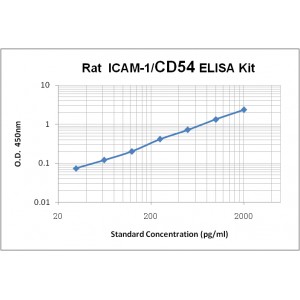More info
Assay Range | 31.2-2,000 pg/mL |
Sensitivity | 2.0 pg/mL |
Specificity | No cross-reaction with other related substances detected |
Size | 96T |
Storage | Store at 2 - 8ºC. Keep reconstituted standard and detection Ab at -20 ºC |
Assay Principle | Sandwich ELISA |
Sample Volume | 100 µL final volume, dilution factor varies on samples |
Detection Method | Chromogenic |
Kit Components
1. Recombinant Rat ICAM-1 standard: 2 vials
2. One 96-well plate coated with Rat ICAM-1 Ab
3. Sample diluent buffer: 12 mL - 1
4. Detection antibody: 130 µL, dilution 1:100
5. Streptavidin-HRP: 130 µL, dilution 1:100
6. Antibody diluent buffer: 12 mL x1
7. Streptavidin-HRP diluent buffer: 12 mL x1
8. TMB developing agent: 10 mL x1
9. Stop solution: 10 mL x1
10. Washing solution (20x): 25 mL x1
Background
ICAM-1 (Intercellular Adhesion Molecule 1), also known as CD54 or major group rhinovirus receptor, is encoded by ICAM1 gene in human. It is a transmembrane glycoprotein belonging to the immunoglobulin superfamily. Human ICAM-1 contains five Ig-like domains in its extracellular domain (ECD) and exists in non-covalently linked dimers. Rat ICAM-1 is composed of a 27 aa signal sequence, a 466 aa extracellular region with five Ig-like domains and eleven potential N-linked glycosylation sites, a 25 aa transmembrane segment, and a 27 aa cytoplasmic domain. The mature rat ICAM-1 shows 52% and 77% aa sequence identity to human and mouse ICAM-1, respectively. The primary ligands of ICAM-1 are the leukocyte integrins LFA-1 (CD11a/CD18) and Mac-1 (CD11b/CD18). At sites of inflammation, ICAM-1 is upregulated on endothelial and epithelial cells to mediate the adhesion and paracellular migration of leukocytes expressing activated LFA-1 and Mac-1. ICAM-1 also binds several non-integrin ligands including CD43/sialophorin, fibrinogen, hyaluronan, rhinoviruses, and Plasmodium falciparum-infected erythrocytes. ICAM-1 ligation prolongs antigen presentation by dendritic cells and promotes T cell proliferation and cytokine release. ICAM-1 mediated cellular processes also play a role in angiogenesis, wound healing, and bone metabolism.
Elevated levels of soluble ICAM-1 (sICAM-1) in serum, cerebrospinal fluid, urine, and bronchoalveolar lavage fluid have been associated with cardiovascular disease, type 2 diabetes, organ transplant dysfunction, oxidant stress, abdominal fat mass, hypertension, liver disease, and certain malignancies. sICAM-1 promotes angiogenesis and may be used as an indicator of vascular endothelial cell activation or damage.


